The art of portraiture underwent a radical transformation in the fifteenth century, particularly in Northern Europe, where the work of Jan van Eyck marked a new chapter in the history of painting.
Foundations of Renaissance Portraiture
Portraiture, while practiced in antiquity and the Middle Ages, had largely been subordinated to religious and symbolic concerns. Medieval likenesses were schematic, often embedded within devotional images or manuscript illuminations, and rarely individualized beyond social markers such as heraldry or attire. It was only with the Northern Renaissance, spearheaded by van Eyck and his contemporaries, that portraiture began to assert itself as a distinct and celebrated genre. In the work of van Eyck, one observes a synthesis of technical innovation, humanist sensibility, and acute attention to individuality that set the stage for centuries of portrait painting.
Portraiture before van Eyck: Medieval Precedents
To understand the revolutionary quality of van Eyck’s contribution, it is essential to situate him within the long arc of portraiture. As Norbert Schneider notes in The Art of the Portrait, before the Renaissance
“the portrait as an autonomous image of an individual scarcely existed” (Schneider 30).
Earlier likenesses—whether imperial coins of antiquity, donor portraits in medieval altarpieces, or funerary effigies—served more to affirm collective authority, dynastic lineage, or spiritual devotion than to convey an individual’s psychological presence.
The Gothic era, for example, favored schematic renderings of kings, bishops, and patrons, whose identities were subsumed under stylized conventions. Yet these depictions carried a powerful symbolic charge. A donor might be portrayed kneeling at the feet of the Virgin Mary, not as a naturalistic likeness, but as a spiritual proxy. Schneider emphasizes that the “autonomous, au vif depiction of persons” truly reemerged only in the fifteenth century, after centuries in which portraiture had been overshadowed by religious art (32).
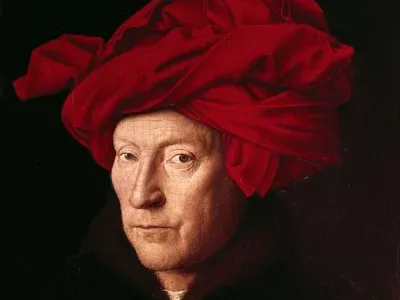
Van Eyck and the Invention of Oil Painting
Jan van Eyck’s pivotal role in the history of portraiture owes as much to his technical mastery as to his cultural milieu. He is often credited, though somewhat mythically, with the “invention” of oil painting. In fact, the medium was known earlier, but van Eyck refined and popularized its use, exploiting its slow-drying properties to achieve unprecedented subtlety of detail, depth of color, and luminosity (Janson 186). Oil allowed artists to render skin, fabric, jewelry, and hair with a tactile realism that surpassed the tempera techniques dominant in Italian art of the early fifteenth century.
In works such as the Arnolfini Portrait (1434, National Gallery, London), van Eyck employed multiple translucent glazes to create a sheen that mimicked natural light. The mirror, chandelier, and convex surfaces in the painting do more than display virtuosity; they testify to a new conception of painting as a window into reality. As Janson observes, the development of oil enabled “a level of microscopic attention to detail” that redefined the very aims of portraiture (190).
The Emergence of the Individual
Van Eyck’s portraits are remarkable not merely for their technique but for their engagement with the notion of individuality. In his Portrait of a Man (Self-Portrait?), inscribed with the words “Als ich can” (“As well as I can”), the sitter confronts the viewer with an almost unsettling directness. The stubbled skin, bloodshot eyes, and meticulously observed folds of the red turban suggest a living presence rather than an idealized type. Schneider underlines how such works embodied “a bourgeois culture increasingly confident in its self-image and autonomy” (Schneider 52).
This confidence is perhaps best illustrated in van Eyck’s Arnolfini Portrait, which depicts the Italian merchant Giovanni di Nicolao Arnolfini and his wife Giovanna Cenami. While often interpreted as a marriage portrait, the painting also projects wealth, status, and personal identity through meticulously rendered objects: the imported oranges, the fur-lined garments, the brass chandelier, and the convex mirror inscribed with van Eyck’s signature. The inclusion of the artist’s name on the wall—“Johannes de Eyck fuit hic” (“Jan van Eyck was here”)—asserts not only the authenticity of the moment but also the agency of the painter as a witness to individuality.
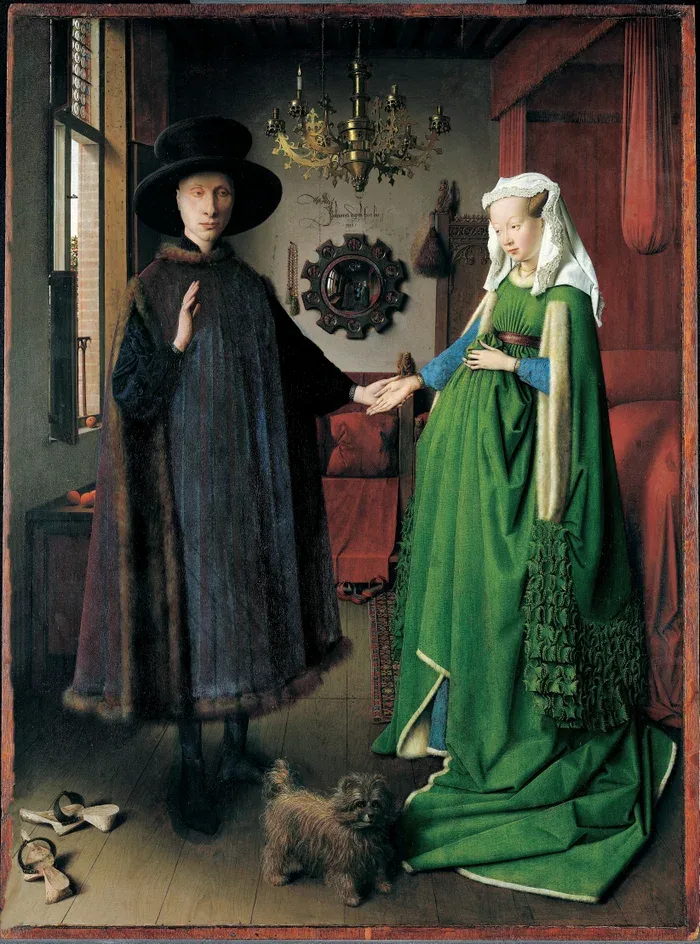
Here, portraiture becomes a nexus of multiple ambitions: the sitter’s desire for commemoration, the artist’s claim to authorship, and the culture’s embrace of empirical observation. Van Eyck’s portraits are not simply likenesses; they are statements about the emerging modern conception of the self.
Symbolism and Realism
Yet van Eyck’s realism is never devoid of symbolism. The minute details in his portraits often carry allegorical weight. In the Arnolfini Portrait, the discarded shoes have been read as symbols of the sanctity of marriage, while the lit candle in the chandelier may represent divine presence. The convex mirror at the center, reflecting not only the couple but also two additional figures, has been interpreted as an all-seeing eye of God. As Janson remarks, van Eyck combined “the visible world and the invisible meaning” with unparalleled subtlety (Janson 192).
This duality between realism and symbolism is central to van Eyck’s revolution. Unlike medieval depictions that relied on overt allegory, van Eyck embedded meaning within naturalistic detail. The viewer is invited to contemplate the symbolic resonance of objects even as they are dazzled by their verisimilitude.
Comparison with Italian Developments
It is instructive to compare van Eyck’s portraits with contemporary Italian works. In Florence, artists like Masaccio and Fra Angelico were exploring linear perspective and monumental form, but their portraits often retained an idealizing quality. By contrast, van Eyck’s northern sensibility emphasized empirical observation over ideal proportion. His sitters were not abstract embodiments of virtue but recognizable individuals, rendered with the precision of a notary’s document. Schneider notes that this divergence reflects broader cultural differences: the humanist courts of Italy sought the “ideal,” while the mercantile societies of the north demanded the “real” (Schneider 66).
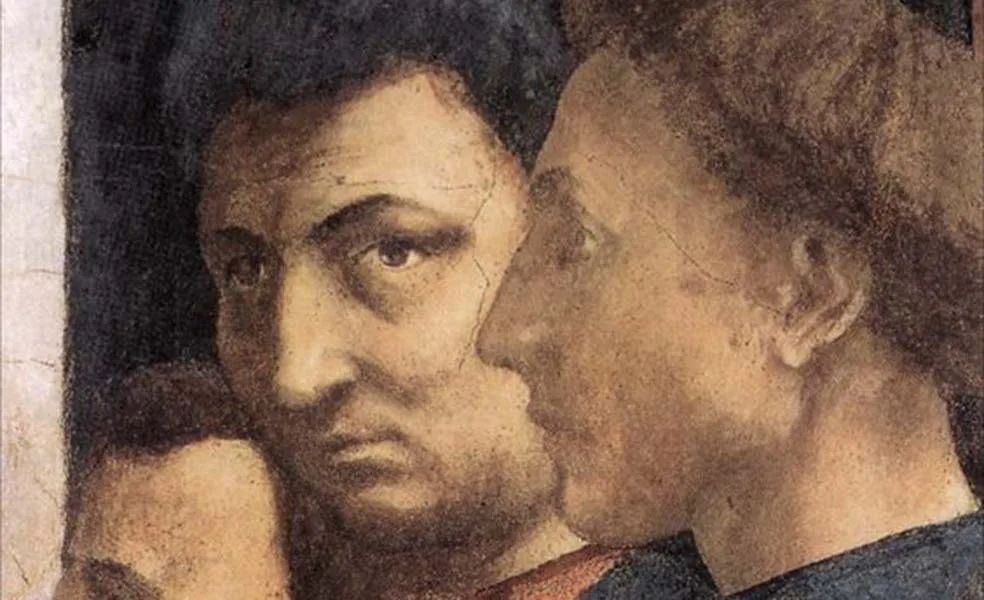
The Function of Portraiture in Renaissance Society
Van Eyck’s portraits served multiple functions. For merchants like Arnolfini, they affirmed economic success and social mobility. For nobles and rulers, they broadcast authority, often rivaling written documents in their evidentiary power. The inscription in van Eyck’s Tymotheos portrait—“Leal Souvenir”—functions like a notarial seal, certifying both likeness and memory (Schneider 72). Portraits could be used in diplomacy, marriage negotiations, and even legal disputes. Their circulation across courts and cities testified to the increasingly mobile and interconnected world of fifteenth-century Europe.
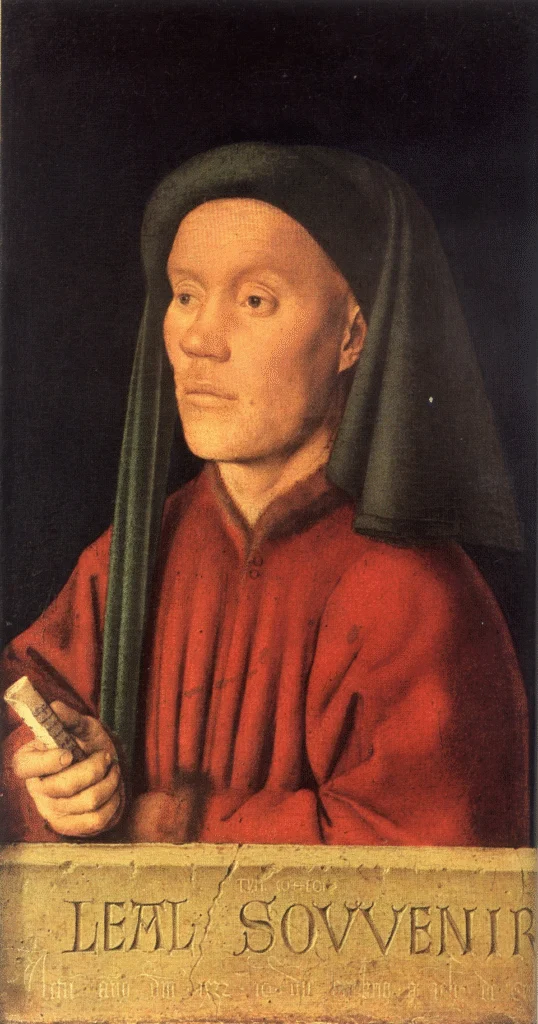
Moreover, the rise of portraiture coincided with broader philosophical currents. Renaissance humanism, with its emphasis on individual dignity and agency, found visual expression in the new art of portraiture. As Pico della Mirandola famously asserted in Oration on the Dignity of Man, humanity possessed the freedom to shape its own identity. Van Eyck’s portraits gave this philosophical abstraction a concrete, visible form.
Legacy of Van Eyck
Van Eyck’s innovations reverberated across Europe. Italian artists such as Antonello da Messina absorbed his meticulous realism, while German masters like Albrecht Dürer carried forward his commitment to individuality. The Flemish tradition established by van Eyck would culminate in the psychological portraits of Hans Holbein the Younger and, ultimately, in the chiaroscuro-laden canvases of Rembrandt. In each case, the seeds planted by van Eyck—technical mastery, symbolic subtlety, and psychological presence—bore fruit in new cultural contexts.
Thus, Jan van Eyck did more than perfect oil painting or pioneer realism; he inaugurated a new way of seeing the human subject. His portraits bridged the medieval concern with symbolism and the Renaissance fascination with individuality, offering images that continue to captivate viewers for their uncanny vitality. In them, the Renaissance ideal of the self was not merely proclaimed but made visible, setting the stage for the evolution of portraiture in the centuries that followed.
PART 2
Italian Renaissance Humanism and the Rise of the Idealized Portrait
If the Northern Renaissance, through Jan van Eyck and his contemporaries, set the stage for a new vision of portraiture centered on verisimilitude and empirical observation, the Italian Renaissance took portraiture in a different direction: toward the ideal. Where Flemish masters sought to capture every wart, wrinkle, and stray hair, Florentine and Venetian artists emphasized harmony, proportion, and beauty. The Italian Renaissance portrait was not merely a record of an individual face; it was a philosophical statement, a reflection of humanist ideals that linked beauty, virtue, and the dignity of the human being.
Humanism and the Renaissance Context
Italian portraiture developed within the intellectual ferment of Renaissance humanism, a movement that emphasized the study of classical antiquity and celebrated humanity’s potential for self-fashioning. In his Oration on the Dignity of Man (1486), Giovanni Pico della Mirandola famously described man as a creature without fixed nature, free to shape himself according to his own will. This philosophical framework encouraged artists to depict not only the likeness of their sitters but also the nobility of their character.
As H. W. Janson explains, Renaissance art in Italy was profoundly shaped by
“the rediscovery of antiquity and the belief that human beings were capable of shaping their own destiny through reason and virtue” (Janson 154).
This humanist vision gave birth to portraits that sought to capture not just the outer appearance of a sitter but their inner essence as a virtuous, rational, and beautiful being.
Florence and the Profile Tradition
The earliest Renaissance portraits in Italy were heavily indebted to classical prototypes. Many Florentine portraits of the fifteenth century, particularly of women, were painted in strict profile, recalling Roman coinage and medallions. The rigidity of profile portraiture lent dignity and order to the sitter, but it also suppressed individuality.
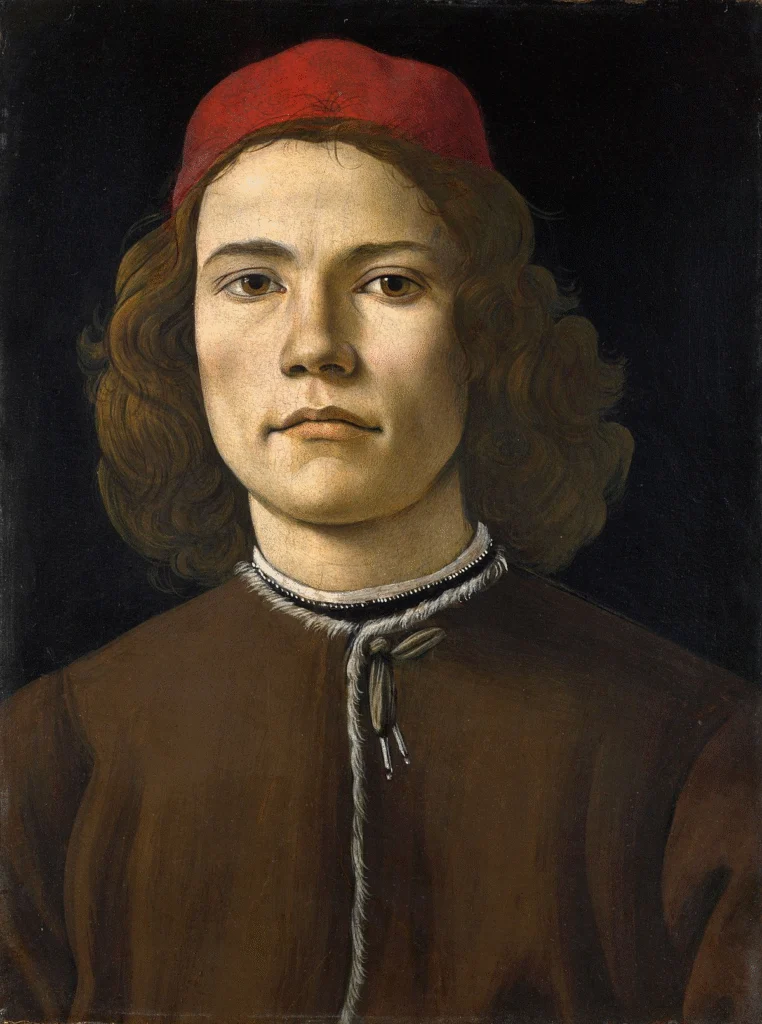
For instance, Sandro Botticelli’s Portrait of a Young Man (c. 1480) maintains an almost sculptural clarity. The sitter’s features are finely drawn, but the emphasis lies less on psychological penetration than on harmonious proportion and idealized beauty (Schneider 52). Similarly, female portraits such as Botticelli’s Portrait of a Lady Known as Smeralda Bandinelli offer elegance and composure rather than personality.
Norbert Schneider emphasizes that these portraits were less about personal likeness and more about the social and moral role of the sitter: “Renaissance portraits of women were often celebratory images of brides, constructed to symbolize virtue, chastity, and family honor” (Schneider 64). Thus, even as the Renaissance discovered the individual, it often subordinated individuality to idealized types.
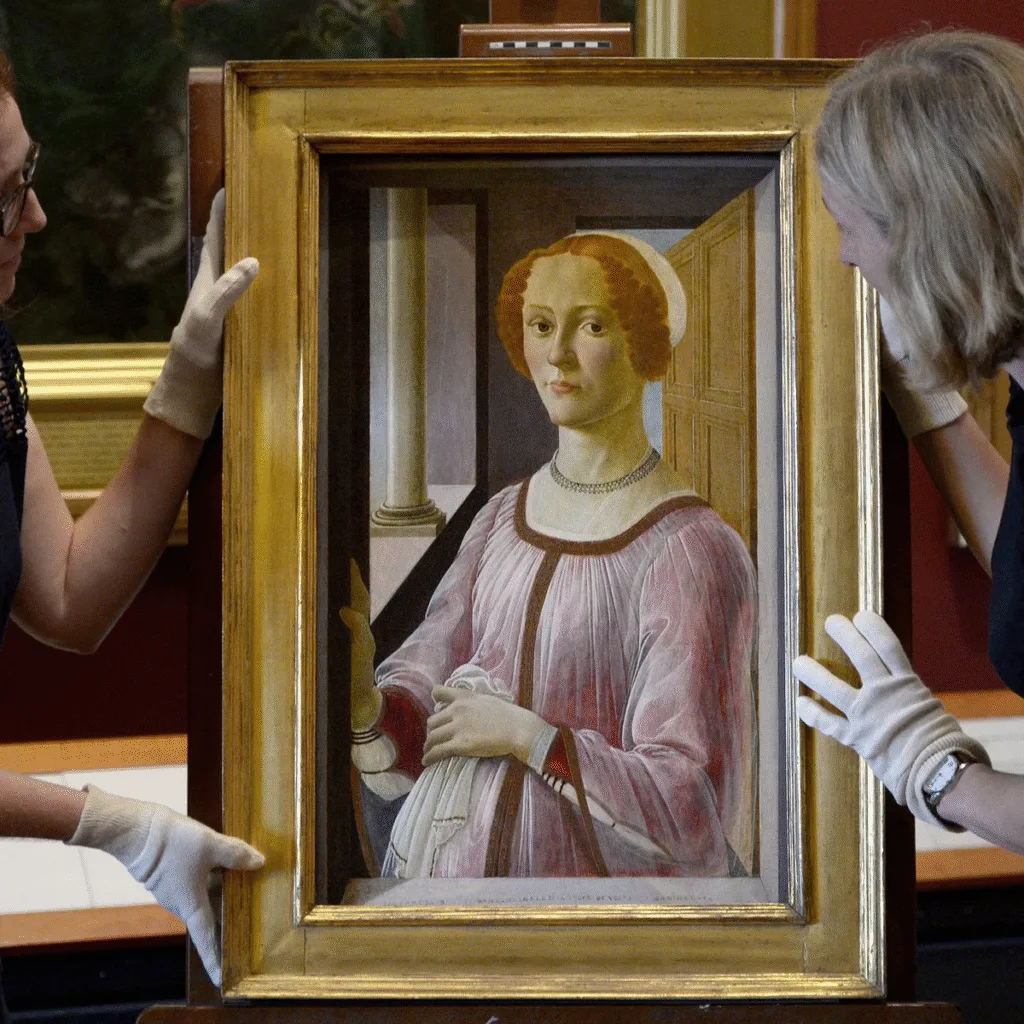
Leonardo da Vinci and the Synthesis of Science and Idealism
Leonardo da Vinci’s portraiture represents a turning point in the evolution of the genre. Leonardo combined van Eyck’s attention to natural detail with the Italian obsession with ideal form. His Mona Lisa (c. 1503–06), perhaps the most famous portrait in the world, exemplifies this synthesis.
Unlike the rigid profiles of earlier Florentine portraits, the Mona Lisa presents the sitter in three-quarter view, engaging the viewer with a direct gaze. Leonardo’s use of sfumato—the subtle gradation of tone—creates an atmospheric softness that lends the portrait its enigmatic character. While the sitter’s exact identity remains debated, what is clear is that Leonardo sought to capture more than appearance: he rendered a psychological presence that transcends individual likeness.
As Janson notes, Leonardo’s portraits mark the moment when “the scientific study of anatomy and optics merged with an ideal of beauty rooted in antiquity, producing a new kind of image that was both exact and transcendent” (Janson 162). The Mona Lisa thus embodies the Renaissance conviction that art could reveal the inner harmony of nature and the human soul.

Raphael and the Poetics of Grace
Where Leonardo sought mystery, Raphael pursued clarity and grace. His portraits, such as the Portrait of Baldassare Castiglione (1514–15), combine precise likeness with a poetic serenity that reflects the sitter’s humanist ideals. Castiglione, author of The Book of the Courtier, was himself a theorist of Renaissance ideals of behavior. Raphael’s portrait captures his subject’s inner balance, his composure and quiet dignity, qualities aligned with Castiglione’s own philosophy of sprezzatura, or effortless grace.
Raphael’s female portraits, such as La Donna Velata (c. 1513), similarly merge realism with idealization. The sitter, identified by some scholars as Raphael’s lover, is presented with luminous clarity, her features softened to convey a universal type of beauty. Schneider underscores that Raphael’s women embody “not only personal identity but the Renaissance aspiration toward harmony between the human and the divine” (Schneider 110).

Venice and the Cult of Color
While Florence emphasized design (disegno), Venice emphasized color (colorito), and this difference profoundly shaped Venetian portraiture. Giovanni Bellini’s Portrait of Doge Leonardo Loredan (1501–05) exemplifies the Venetian approach.
The Doge, Venice’s leader, is shown in frontal view, richly dressed in ceremonial robes. The portrait conveys authority, but its effect derives less from sculptural form than from the shimmering interplay of light on fabric and flesh.
Titian, Bellini’s successor, brought Venetian portraiture to new heights. His Portrait of a Man (Ariosto?) (c. 1512) established a type that would influence generations: the half-length, three-quarter view, with the sitter resting on a parapet and gazing outward.

Unlike the cool detachment of earlier Florentine portraits, Titian’s figures exude vitality and immediacy. The texture of skin, the richness of garments, and the atmospheric backgrounds reflect Venetian mastery of oil paint.
As Janson explains, Titian transformed portraiture into “a vehicle not only for likeness but for the dramatic assertion of personality and presence” (Janson 180). His portraits of rulers, such as Emperor Charles V, fused individuality with political grandeur, establishing the equestrian and state portrait traditions that would dominate the Baroque.
The Function of Portraiture in Italy
Italian Renaissance portraits fulfilled multiple roles. They served as commemorations of marriage alliances, as records of dynastic continuity, as political propaganda, and as private expressions of friendship or devotion. Raphael’s portrait of Pope Julius II (1511–12) conveyed papal authority through solemn introspection, while Titian’s portraits of noblemen became symbols of aristocratic power.

At the same time, portraits circulated as portable objects of memory and diplomacy. As Schneider notes, “Portraits were often sent across Europe in the context of marriage negotiations, serving as both likeness and political statement” (Schneider 120). Portraiture thus became a vital tool in the construction of both personal and collective identity in Renaissance Italy.
The Ideal and the Individual
In contrast to van Eyck’s microscopic realism, the Italian Renaissance portrait sought to balance the real and the ideal. It pursued beauty as a moral and philosophical category, linking outer appearance to inner virtue. Yet this pursuit of idealization sometimes diminished individuality. The serene faces of Botticelli’s women, Raphael’s Madonnas, and even the enigmatic Mona Lisa transcend the particular to embody universal ideals.
Nevertheless, the Italian contribution to portraiture was crucial. By infusing likeness with philosophical depth and classical ideals, Italian artists elevated portraiture from mere record to high art. They transformed the portrait into a stage on which the dignity of humanity could be displayed, not only in the face of rulers and nobles but also in the countenance of scholars, poets, and merchants.
Toward a Broader Human Image
The Italian Renaissance did not abandon realism; it incorporated it into a broader pursuit of harmony and beauty. If van Eyck gave portraiture the gift of lifelike detail, Leonardo, Raphael, and Titian endowed it with a language of grace, proportion, and color. The result was a new type of portrait—simultaneously naturalistic and idealized—that reflected the humanist conviction that humanity was the measure of all things.
As the sixteenth century progressed, the Northern and Italian traditions would increasingly interact, culminating in the psychological intensity of Holbein in Germany and the Netherlands, and later, in the grandeur of Baroque portraiture. But the foundations of this later development lay in the Renaissance synthesis of realism and idealism. Italian artists redefined the portrait as a philosophical and aesthetic statement, a mirror not only of the face but of the soul.
PART 3
Northern European Psychological Portraiture – Holbein, Dürer, and Beyond
While Italian Renaissance portraiture sought harmony and idealization, the portrait tradition in Northern Europe took a different turn during the sixteenth century. Building upon the legacy of Jan van Eyck and Rogier van der Weyden, northern artists increasingly emphasized psychological depth, individuality, and acute observation of detail. This was not a rejection of Renaissance humanism but rather a distinct expression of it—one that highlighted interior life and intellectual identity. Nowhere is this clearer than in the portraits of Hans Holbein the Younger, Albrecht Dürer, and their contemporaries, who infused portraiture with an unprecedented intensity of presence.
The Merchant Portrait and the Rise of the Bourgeoisie
The early modern period saw the steady rise of the urban middle classes, especially merchants and bankers who played an increasingly significant role in European society. This new class demanded portraits that reflected their economic success and cultural refinement. Schneider observes that “from the fifteenth century onwards, not only princes and nobles, but merchants, craftsmen, and humanists sat for their portraits, keeping themselves, quite literally, in the public eye” (Schneider 30).

Hans Holbein’s Portrait of Georg Gisze (1532) epitomizes this development. Gisze, a merchant from Danzig working in London, is depicted surrounded by the instruments of his trade—scales, seals, letters, and a vase of carnations. The Latin inscription on the wall certifies the accuracy of the likeness, underscoring the portrait’s quasi-documentary authority. Yet Holbein’s painting is not a mere inventory of objects. The sitter’s intense gaze and composed demeanor convey intelligence, dignity, and moral seriousness. As Schneider explains, Holbein’s portraits present their sitters as “autonomous individuals, self-assured in their public and private roles” (Schneider 48).
In such works, the portrait became a stage for bourgeois self-fashioning. The detailed surroundings and symbolic objects served as a visual curriculum vitae, communicating the sitter’s identity, profession, and values to viewers.
Albrecht Dürer and the Artist as Subject
If merchants sought portraits as markers of status, artists like Albrecht Dürer used portraiture as a vehicle for self-definition. Dürer’s self-portraits are among the most striking in art history, not only because of their technical brilliance but also because of their bold assertion of the artist’s role in society.

His Self-Portrait at the Age of 28 (1500, Alte Pinakothek, Munich) presents Dürer in frontal pose, reminiscent of Christ icons. The symmetry of the composition, the direct gaze, and the raised hand gesture all echo traditional religious imagery. By appropriating such a format, Dürer elevated the image of the artist to near-sacred status. As Janson observes, Dürer here “proclaimed the dignity of the artist as a creator, placing himself on a par with God’s own creative power” (Janson 276).
Earlier self-portraits, such as his youthful likenesses of 1493 and 1498, had already demonstrated his concern with fashion, identity, and artistic persona. But the 1500 portrait crystallized a new Renaissance ideal: the artist not as anonymous craftsman but as intellectual, philosopher, and visionary. Dürer’s self-portraits, therefore, were not just exercises in likeness—they were manifestos of artistic identity.
Humanist Portraiture: Erasmus and the Scholar’s Image
Holbein, who worked in Basel and later in the English court, exemplified the fusion of northern realism with humanist ideals. His portraits of the Dutch humanist Erasmus capture not only the likeness of the famous scholar but also his intellectual temperament. Erasmus is often shown absorbed in his books, pen in hand, embodying the virtues of study, learning, and contemplative life.
Schneider notes that portraits of humanists and scholars “were intended to project an image of intellectual seriousness and moral rectitude” (Schneider 76). Such portraits often eschewed opulent clothing or lavish backgrounds in favor of simple settings that emphasized the sitter’s inner life. This shift reflected the values of Renaissance humanism, which privileged learning and virtue over material wealth.
In this sense, the northern portrait tradition paralleled Italian humanism but gave it a different visual vocabulary—one less concerned with ideal beauty and more with psychological resonance.
Psychological Penetration and Physiognomy
One of the most distinctive qualities of Northern Renaissance portraiture was its fascination with the human face as a window to the soul. As interest in physiognomy—the study of facial features as indicators of character—spread through Europe, artists sought to capture subtle nuances of expression, gesture, and temperament.
Dürer, for example, produced countless studies of heads, experimenting with the relationship between physical appearance and inner disposition. Holbein, too, excelled at rendering expressions that suggested thoughtfulness, melancholy, or resolve. His Portrait of Sir Thomas More presents the English statesman with tightly compressed lips and penetrating eyes, conveying both determination and moral gravity.

Schneider cautions, however, against over-reading these expressions: “It is doubtful whether today’s spectator can interpret the sitter’s gestures correctly at all” (Schneider 90). Still, the attempt to capture psychological depth distinguished northern portraiture from the more idealized Italian approach.
The Group Portrait and Collective Identity
Another northern innovation was the group portrait, particularly in the Netherlands. As civic guilds, confraternities, and militias gained importance, they commissioned portraits to commemorate their collective identity. These paintings balanced individual likeness with corporate unity.
Though the great flowering of civic guard portraits would come in the seventeenth century with Frans Hals and Rembrandt, the roots lie in sixteenth-century group portraits that depicted guild members or family groups in orderly arrangements. Schneider emphasizes that such portraits “served as status symbols for corporate bodies, while at the same time defining the various roles and hierarchies within the groups themselves” (Schneider 38).
The Protestant Reformation and Portraiture
The Protestant Reformation also influenced portraiture in northern Europe. Religious iconoclasm reduced opportunities for sacred art, and portraiture became a crucial medium for personal expression and commemoration. Luther himself was portrayed by Lucas Cranach the Elder in numerous likenesses, which circulated widely in print and painting.
These portraits of reformers served a dual function: they were both personal likenesses and instruments of propaganda, presenting religious leaders as sober, authoritative, and virtuous. Thus, portraiture in the north became increasingly tied to issues of belief, identity, and persuasion.
Toward the Baroque: The Seeds of Theatricality
By the late sixteenth century, northern portraiture began to absorb Italian influences, especially through the spread of Mannerism. Elongated proportions, elaborate poses, and dramatic settings entered northern art, particularly in the work of court painters like Anthonis Mor and later Rubens and van Dyck. Yet the northern tradition retained its commitment to individuality and psychological presence.
The balance between realism and theatricality would culminate in the Baroque, where portraiture became a stage for power, prestige, and drama. But even in this shift, the legacy of Dürer and Holbein remained vital: the insistence that a portrait must capture not only the body but also the mind and soul.
The Northern Contribution
Northern European portraiture in the sixteenth century deepened the genre’s engagement with individuality and psychology. Holbein’s merchants and scholars, Dürer’s self-portraits, and Cranach’s reformers all testify to a culture fascinated with the human face as the locus of identity. These portraits went beyond surface likeness to suggest inner character, intellectual pursuits, and moral values.
As Janson concludes, “The north contributed to the evolution of portraiture its unparalleled concern with the particular, the psychological, and the real” (Janson 290). This contribution would prepare the ground for the great flowering of Baroque portraiture in the seventeenth century, where artists like Rubens, van Dyck, Hals, and Rembrandt would synthesize northern realism with Italian grandeur.
PART 4
Baroque Portraiture and the Power of Image – Rubens, van Dyck, and Court Splendor
The seventeenth century marked a new era for portraiture: the Baroque. Whereas Renaissance portraiture had been shaped by ideals of balance, harmony, and individuality, Baroque portraiture embraced grandeur, theatricality, and spectacle. Portraits became instruments of power, designed to awe the viewer as much as to record a likeness. At the courts of Europe—in Spain, France, the Netherlands, and England—portraiture functioned as propaganda, reinforcing political authority and social hierarchy. The work of artists such as Peter Paul Rubens and Anthony van Dyck epitomized this transformation, forging images that were both personal likenesses and visual assertions of dynastic legitimacy.
The Baroque Context: Splendor and Propaganda
The Baroque period emerged in the context of the Counter-Reformation and the consolidation of absolute monarchies. Art became a tool of persuasion, employed by both the Catholic Church and secular rulers to inspire loyalty and obedience. Portraiture, in particular, played a central role in projecting the magnificence of rulers and their courts.
As Janson notes, Baroque art was characterized by its “dynamic movement, dramatic contrasts of light and dark, and overwhelming sense of grandeur” (Janson 700). These qualities translated into portraiture as well. Sitters were no longer depicted as static figures but as actors on a stage, illuminated by theatrical light, draped in sumptuous fabrics, and set against architectural or allegorical backdrops. The portrait became less a mirror of individuality than a tableau of power.
Rubens: Monumentality and Allegory
Peter Paul Rubens, active in Antwerp and across European courts, epitomized the Baroque conception of portraiture as grandeur. Known for his dynamic compositions and fleshy, vibrant figures, Rubens infused his portraits with monumentality and allegorical resonance.
In his Portrait of Marchesa Brigida Spinola-Doria (1606),

the sitter is enveloped in opulent silks and jewels, towering against an architectural backdrop. Her stance is commanding, almost regal, despite her youth. The portrait functions as much as a declaration of family prestige as it does a likeness. Schneider emphasizes that Rubens’s portraits “sought to elevate the sitter into the realm of myth, blending realism with allegory” (Schneider 142).
Rubens also painted rulers, most notably Marie de’ Medici, Queen of France, whose life he commemorated in a monumental cycle now in the Louvre. Although technically a series of history paintings, many of the canvases function as portraits, portraying the queen in mythological guise—guided by gods, crowned by Victory, embraced by France. Here, portraiture transcended mere likeness to become state propaganda, mythologizing political authority.
Van Dyck: The Elegance of Courtly Portraiture
If Rubens embodied grandeur, his pupil Anthony van Dyck refined it into elegance. Van Dyck became the preeminent portraitist of European nobility, especially in England, where he served as court painter to King Charles I. His portraits combined Baroque theatricality with aristocratic grace, establishing conventions that would dominate portraiture for centuries.

Van Dyck’s Charles I at the Hunt (c. 1635) exemplifies his approach. The king is shown informally, leaning on a walking stick, dressed in civilian clothes rather than regal robes. Yet the portrait conveys unmistakable authority. The low vantage point makes Charles appear taller and more imposing than he was in reality, while the landscape background suggests dominion over nature itself. Schneider notes that such portraits exemplify the “aristocratic cult of refinement, where elegance and poise became the visual language of power” (Schneider 124).
Van Dyck’s equestrian portraits of Charles I likewise drew upon the ancient Roman tradition of imperial statuary. These works communicated martial prowess and sovereign authority, even though Charles himself was far from a successful military leader. The equestrian portrait thus became a carefully constructed fiction—a powerful image of kingship rather than a reflection of reality.
Portraiture as Theater
A hallmark of Baroque portraiture was its theatrical quality. Sitters were staged as if on a grand stage, lit dramatically, surrounded by draperies, columns, or expansive landscapes. These settings amplified their status and suggested connections to history, mythology, or divine order.
As Janson explains, Baroque portraiture often blurred the line between portrait and history painting, “endowing the sitter with allegorical attributes that linked individual likeness to universal themes of power, virtue, or piety” (Janson 740). A noblewoman might be portrayed as a goddess, a ruler as a Roman general, a child as a putto or cherub. Such allegorical portraits reinforced social hierarchies by situating individuals within a cosmic order.
Spanish Baroque Portraiture: Dignity and Restraint
While Rubens and van Dyck epitomized flamboyance and elegance, Spanish Baroque portraiture developed a more austere aesthetic. Diego Velázquez, court painter to Philip IV, imbued his portraits with restraint and psychological subtlety.

His Portrait of Philip IV in Brown and Silver (1631–32) presents the king with sober dignity, devoid of theatrical excess. Yet the precision of Velázquez’s brushwork and the controlled luminosity elevate the image into an assertion of authority. Velázquez’s genius lay in balancing realism with majesty: his sitters are individualized, yet they radiate the aura of power.
The Las Meninas (1656), while not strictly a portrait, epitomizes this synthesis. The painting includes likenesses of the Infanta Margarita, her entourage, and Velázquez himself, but its complexity transcends the genre. It reflects on the act of representation itself, elevating portraiture to the level of philosophical inquiry.
Dutch Baroque: Civic Portraiture and Collective Identity
In the Netherlands, freed from monarchical courts, portraiture took on different forms. Civic guard portraits, regent group portraits, and family portraits flourished, reflecting the values of a republican society.

Frans Hals, with his vigorous brushwork, captured the liveliness of civic militias in works like The Banquet of the Officers of the St. George Militia Company (1616). Unlike van Dyck’s aristocratic elegance, Hals’s portraits exude conviviality and spontaneity, qualities prized by the Dutch bourgeoisie.
Rembrandt, as will be discussed in the next section, transformed the group portrait into a profound meditation on human psychology, most famously in The Night Watch (1642). Even before Rembrandt, however, Dutch Baroque portraiture reflected a unique blend of individuality and collective identity, distinct from the aristocratic models of southern Europe.
Portraiture and Gender
The Baroque period also produced striking portraits of women, though often within the constraints of patriarchal society. Noblewomen were portrayed as embodiments of virtue, chastity, or beauty, their identities subsumed under allegorical roles. Yet within these frameworks, artists sometimes captured genuine individuality. Van Dyck’s Portrait of Queen Henrietta Maria reveals not only her royal status but also her delicate, melancholic character. Similarly, Rubens’s portraits of his wives, Isabella Brant and Hélène Fourment, combine marital symbolism with palpable affection.

The Baroque Legacy
Baroque portraiture expanded the genre to unprecedented scale and grandeur. It transformed portraits into instruments of power, vehicles of propaganda, and stages for aristocratic display. Yet within this theatricality, artists like Velázquez and Rembrandt found ways to explore psychological depth and human complexity.
As Schneider concludes, “the portrait of the seventeenth century was both a likeness and a symbol, both individual and universal, both private and public” (Schneider 158). This duality ensured the vitality of portraiture, making it the dominant form of secular painting in early modern Europe.
From Splendor to Soul
The Baroque era demonstrated the potential of portraiture to construct and project identity on a grand scale. Rubens’s allegorical queens, van Dyck’s elegant nobles, and Velázquez’s austere monarchs all reveal how portraits could embody not only the sitter’s likeness but also their role in a broader social and political order. Portraits became theatrical spectacles, designed to impress, persuade, and endure.
Yet this grandeur would eventually give way to another approach, pioneered by Rembrandt: a turn inward, toward the soul. Where Rubens and van Dyck staged their sitters as actors in allegorical dramas, Rembrandt explored the unvarnished humanity of his subjects. His portraits, as we shall see, marked the culmination of centuries of development, synthesizing northern realism and Baroque drama into images of unparalleled psychological depth.
PART 5
Rembrandt and the Interior Turn – Portraits of the Soul
The culmination of portraiture’s evolution from the fifteenth to the seventeenth century can be found in the work of Rembrandt van Rijn. Where Jan van Eyck introduced lifelike detail, where Leonardo and Raphael pursued idealized harmony, and where Rubens and van Dyck projected theatrical grandeur, Rembrandt turned inward. His portraits probed the human psyche, capturing the fragility, dignity, and complexity of the individual. In doing so, Rembrandt transformed portraiture from a public statement of status into a deeply personal exploration of the human condition.
Rembrandt in Context
Born in Leiden in 1606, Rembrandt rose to prominence in Amsterdam during the Dutch Golden Age. Unlike the courtly settings of southern Europe, the Netherlands was a republic where civic institutions, guilds, and wealthy burghers dominated cultural life. Portraiture thrived in this environment, as citizens sought to commemorate their achievements, families, and roles in society.
Yet Rembrandt’s approach to portraiture diverged from that of his Dutch contemporaries. While artists like Frans Hals emphasized vitality and outward display, Rembrandt emphasized introspection and psychological weight. As Janson observes, “Rembrandt transformed the portrait from a likeness into a revelation, making visible the inner life of his sitters” (Janson 912).
Chiaroscuro and the Drama of Light
One of Rembrandt’s most distinctive tools was his mastery of chiaroscuro, the dramatic use of light and shadow. Drawing on the legacy of Caravaggio, Rembrandt used light not merely to model form but to suggest emotional and spiritual meaning. In his portraits, faces emerge from darkness, illuminated by a soft, golden glow that reveals texture, wrinkles, and expression.

This use of light lends his portraits a sense of immediacy and intimacy. In Portrait of Nicolaes Ruts (1631), the sitter’s fur-trimmed cloak and steady gaze are bathed in warm light, emphasizing solidity and presence. Yet in later works, such as Portrait of Jan Six (1654), the light is more diffused, caressing the sitter’s features and imbuing the image with contemplative stillness. Schneider remarks that in Rembrandt’s hands, light became “a metaphor for truth, revealing not only the external likeness but the inner essence of the sitter” (Schneider 130).
The Self-Portraits: A Life in Paint
Rembrandt’s most remarkable contribution to portraiture lies in his unprecedented series of self-portraits—over eighty paintings, drawings, and etchings spanning his entire career. These works constitute not only a record of his physical appearance but also a visual autobiography.
The early self-portraits from the 1620s show Rembrandt experimenting with dramatic expressions, costumes, and poses, as if testing the possibilities of identity. By the 1630s, he depicted himself with the confidence of a successful young artist, clothed in fine attire and gazing directly at the viewer. Yet as the decades passed and Rembrandt faced personal tragedies—such as the deaths of his wife Saskia and several of his children—and financial ruin, his self-portraits took on a new character.

In his late self-portraits, such as the one in the Frick Collection (1658), Rembrandt presents himself with unflinching honesty. The sagging skin, weary eyes, and heavy hands reveal the toll of age and hardship, yet the dignity of the pose and the commanding presence affirm resilience. As Janson observes, “no other artist has so relentlessly confronted his own humanity on canvas, transforming self-portraiture into a meditation on existence itself” (Janson 958).
These self-portraits are not simply records of a face but existential statements. They invite viewers to reflect on mortality, suffering, and endurance—universal themes that transcend the individual.
The Group Portrait: The Night Watch
Rembrandt also revolutionized the Dutch tradition of the group portrait. Earlier civic guard portraits, like those of Hals, typically showed members lined up in orderly fashion, each granted equal visibility. Rembrandt broke this convention in The Night Watch (1642).

Instead of a static arrangement, Rembrandt depicted the militia in dynamic action, as Captain Frans Banning Cocq leads his company forward. Figures are partially obscured, illuminated unevenly, and engaged in various tasks. The result is not a mere roster of faces but a theatrical scene infused with narrative energy.
Though controversial at the time—some sitters complained about being relegated to the shadows—The Night Watch redefined the group portrait as a dramatic composition rather than a literal record. Schneider emphasizes that Rembrandt “sacrificed the equality of representation for the sake of unity and vitality, turning a civic document into a masterpiece of art” (Schneider 158).
Portraits of the Soul
What sets Rembrandt apart from his contemporaries is his relentless pursuit of the inner life. His portraits often eschew lavish settings or costumes, focusing instead on the human face. The wrinkled skin of an old woman, the weary gaze of a scholar, the vulnerability of a child—all are rendered with compassion and empathy.

In The Jewish Bride (c. 1665), often interpreted as a double portrait of a couple, Rembrandt portrays not only the likeness of two sitters but the tenderness of their relationship. The man’s protective gesture and the woman’s serene acceptance speak volumes about intimacy, trust, and love. As Janson remarks, the painting “reveals emotions that words cannot capture, transforming portraiture into a poetry of the human spirit” (Janson 960).
Even commissioned portraits, such as those of Amsterdam’s regents, bear the imprint of Rembrandt’s psychological depth. Unlike the polished elegance of van Dyck’s aristocrats, Rembrandt’s burghers appear contemplative, burdened, and human. Their authority is conveyed not through pomp but through gravity of character.
The Legacy of Rembrandt
Rembrandt’s portraits marked both a culmination and a turning point. They synthesized the realism of the north, the idealism of the Italian Renaissance, and the theatricality of the Baroque, yet they went beyond all three. His portraits were not merely likenesses or symbols of power but explorations of human existence.
Schneider summarizes this achievement: “Rembrandt gave the portrait a depth and universality that elevated it above its social function, turning it into a mirror of the human soul” (Schneider 162). His influence resonated through later centuries, inspiring artists from Goya to Van Gogh, from Käthe Kollwitz to Francis Bacon. Each, in their own way, grappled with the challenge of capturing not just appearance but essence.
See Portraits from Modern Artists
Conclusion: From Likeness to Humanity
The evolution of portraiture from Jan van Eyck to Rembrandt charts a remarkable journey. What began in the fifteenth century as a rediscovery of individual likeness blossomed into an art form capable of expressing the highest ideals of beauty, power, and truth. Van Eyck’s microscopic realism, Leonardo’s idealized harmony, Holbein’s psychological depth, van Dyck’s aristocratic elegance, and Rubens’s allegorical grandeur all contributed to this trajectory.
Yet it was Rembrandt who brought portraiture to its most profound realization: the revelation of humanity itself. His portraits remind us that beneath status, costume, and allegory lies the shared experience of being human. In his canvases, the face becomes a mirror of the soul, inviting us into a dialogue that transcends time.
Thus, the history of portraiture from the fifteenth to the seventeenth century is not merely an art historical narrative but a philosophical one. It is the story of how art came to grapple with the mystery of identity—how painters, through brush, pigment, and light, sought to make visible the inner life of their fellow human beings. In Rembrandt’s hands, the portrait ceased to be an image of power or beauty alone; it became an image of truth.
Works Cited
Janson, H. W., and Anthony F. Janson. History of Art, Volume 1. 4th ed., Prentice Hall, 1991.
Schneider, Norbert. The Art of the Portrait: Masterpieces of European Portrait Painting, 1420–1670. Taschen, 2002

